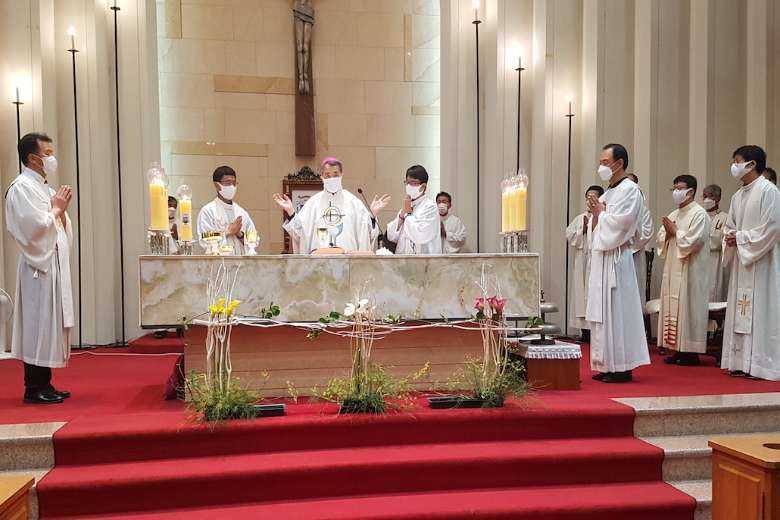
Bishop Pius Chang-woo Moon of Cheju in South Korea celebrates a special Mass to commemorate the 1901 Jeju Uprising. (Photo: Cheju Diocese)
A Catholic diocese in South Korea has unveiled a monument and offered a special Mass to honor hundreds of Catholics and others killed during a violent rebellion more than a century ago.
The Diocese of Cheju that covers Jeju, the largest island of South Korea and a self-governing territory, inaugurated the Tower of Reconciliation following a memorial Mass celebrated by Bishop Pius Chang-woo Moon on May 29.
The program is aimed at enlivening memories of the past with strong calls for harmony among Catholics and non-Catholics on the island, according to the diocese’s website.
For the first time, the Mass also remembered those rebels who opposed the Church and had deadly conflicts with local Catholics.
The event marked the 120th anniversary of the 1901 Jeju People's Uprising, a rebellion against feudalism and colonialism on the island.
The rebellion turned into a conflict between Catholics and others on the island, about 450 kilometers south of Seoul. Of 900 people killed in the fighting, 700 were Catholics.
We should not simply remember the pain but reconcile and join the journey for the future of Jeju
In 2003, the Church and the 1901 Jeju Uprising Commemorative Foundation signed a joint declaration stating that both sides were responsible for the bloodbath in the island.
Cheju Bishop Peter Kang Woo-il and foundation chairpersons Kim Young-hoon and Kim Chang-seon signed the Declaration of Reconciliation for the Future.
Cheju Diocese also held a symposium on the theme of “New Church Plan, Memory and Harmony” at the cathedral parish attended by Bishop Moon and Father Cho Han-geon from the Korean Church History Research Institute.
During the discussion, the bishop said it was the duty of both Catholics and those of other faiths in Jeju to change their perceptions about the century-old conflict and bloodbath and to build a bridge in the spirit of reconciliation to correct historical wrongs.
“We should not simply remember the pain but reconcile and join the journey for the future of Jeju,” said Bishop Moon. “Many people died for the Church, but we need to ask again whether the Church really died for the culture of Jeju island.”
The prelate emphasized that “a new evangelization must sprout through an attitude of listening to Jeju culture and true reconciliation.”
Jeju is famous for its natural beauty but it harbors a dark past, according to Jeju Weekly.
Until the early 19th century, Jeju was a penitentiary where Korean nobles found of guilty of serious offenses were banished. The convicts were still influential and kept themselves apart from natives of Jeju, often looking down on their culture and traditions. The authorities in Seoul appointed governors for Jeju and they were seen as outsiders by locals.
The consequent oppression and abuse of Jeju natives and their culture sparked a series of revolts, which were quickly and violently suppressed by the government. A major cause of rebellions was foreign influence in the form of Western imperialism.
Another trigger for revolt was the imposition of taxation on the island. During the Joseon dynasty's rule (1392-1910) Jeju was exempt from taxes and was only required to send boxes of oranges. In 1897, the government began to levy taxes on the islanders in an effort to raise money for modernization, causing massive public anger.
On March 4, 1898, nearly 6,000 islanders rose up and imprisoned the Jeju governor and his subordinates. The mob armed themselves by looting the government arsenal and burned down government buildings which housed public records. The government sent in the military and brutally quelled the rebellion. With an imperial decree, “loyal islanders” were exempt from taxes and peace was restored.
Peace, however, was short-lived and the island was in turmoil again in 1901. This time, there was a strong Christian dimension to the revolt and consequent bloodbath.
After the signing of the 1886 Friendship Treaty between France and Korea, tension simmered between Catholics and non-Catholics in Jeju. The treaty guaranteed French Catholic missioners extraterritorial rights on Korean soil.
Hundreds of Christians died in brutal skirmishes with the rebels
The natives started to see Korean Catholics as collaborators with imperial foreign powers. The anger was also fueled by official protection for French priests and Korean Catholics that triggered a rise in their numbers. In order to benefit from the protection, many including criminals converted to Catholicism.
According to the Korean Catholic Encyclopedia, the Church’s negative attitude towards local culture and indigenous religion also fueled unrest in Jeju. Catholics were accused of destroying trees and objects considered sacred to local shamanistic beliefs, considering these things objects of superstition or idolatry.
Many of the exiled offenders were Christians and several held positions in the authority who routinely abused native islanders. Ye Yin-yon, a former interpreter for the French legation in Seoul, became the head tax collector on the island, imposing crushing taxes “on almost everything on the island: fish nets, trees, stone walls, pigsties, and everything upon which a tax could in any way be levied.”
Ye also employed several Christians as tax collectors who abused, beat up and angered the islanders. There were also rumors that Christians were exempt from taxes.
Some 10,000 islanders marched in protest and attacked government officials as well as Christians when confronted. Hundreds of Christians died in brutal skirmishes with the rebels and many fled the island before the government dispatched troops and crushed the rebellion.
It is believed about 10,000 civilians were killed during the uprisings in Jeju and the security forces were accused of mass killings.
According to 2020 data, Jeju has about 695,500 residents including more than 75,000 Catholics.


